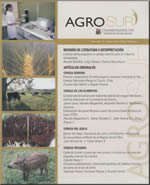ESTRUCTURA POBLACIONAL Y DIVERSIDAD GENÉTICA DE REBAÑOS BOVINOS DE CARNE DEL SUR DE CHILE
Contenido principal del artículo
Resumen
La variabilidad genética presente en especies animales domesticadas ha desaparecido progresivamente debido, en gran parte, a la sustitución de razas y cruzamientos dirigidos destinados a incrementar la productividad y calidad de los productos animales. Lo anterior, ha erosionado características adaptativas presentes en razas locales, tales como resistencia a enfermedades y tolerancia a climas adversos. Actualmente, no existe información suficiente que permita comprender las relaciones genéticas entre los genotipos bovinos localmente adaptados y aquellos exóticos introducidas con posterioridad al país. En las últimas décadas ha existido un notorio aumento en la disponibilidad de marcadores genéticos destinados al estudio de la diversidad genética de especies domesticadas. En este estudio, 10 marcadores microsatélites fueron utilizados para estudiar la diversidad genética y estructura poblacional en un total de 212 individuos (ocho genotipos) distribuidos en diferentes zonas geográficas del país. Los microsatélites fueron amplificados mediante reacciones PCR y los fragmentos amplificados separados electroforéticamente en un secuenciador automático ABI PRISM 310. El estudio describió la estructura poblacional y diversidad genética en ocho genotipos. La determinación de la variabilidad genética mediante el cálculo de frecuencia génica permitió estimar la heterocigosidad por locus que varió entre 0,61 para el marcador SPS115 y 0,85 para el marcador TGLA227, obteniéndose una heterocigocidad media de la población de 0,73. Según el PIC (Contenido de información polimórfica) todos los loci estudiados fueron informativos, encontrándose que para la población de animales analizados los rangos variaron entre 0,58 para el marcador SPS115 y 0,84 para el marcador TGLA227, con un promedio de la población de 0,70. Se concluyó así que dentro de los marcadores microsatelitales analizados se encuentra un alto grado de polimorfismo, variando el número de alelos por locus en la población entre nueve para el marcador SPS115 a 19 para los marcadores TGLA122 e INRA23. De esta forma, el análisis genético realizado evidenció una elevada hibridización entre las razas de carne, con una probabilidad posterior de 0,99 y un promedio de Fst (Indice de diferenciación genética) en la población de 0,1371 (13,7%), lo que confirma una alta variación genética entre las poblaciones analizadas.

